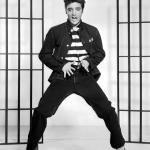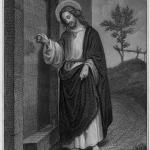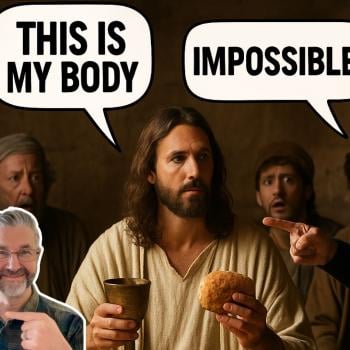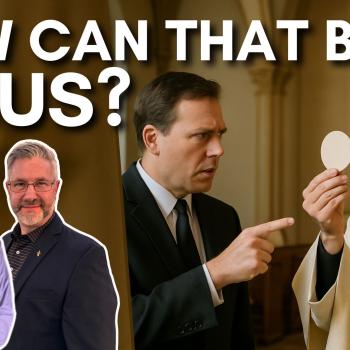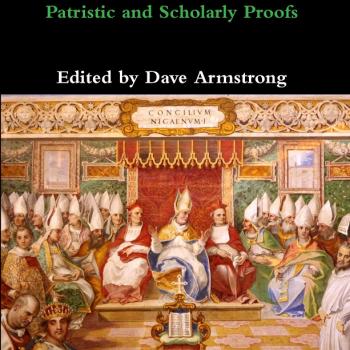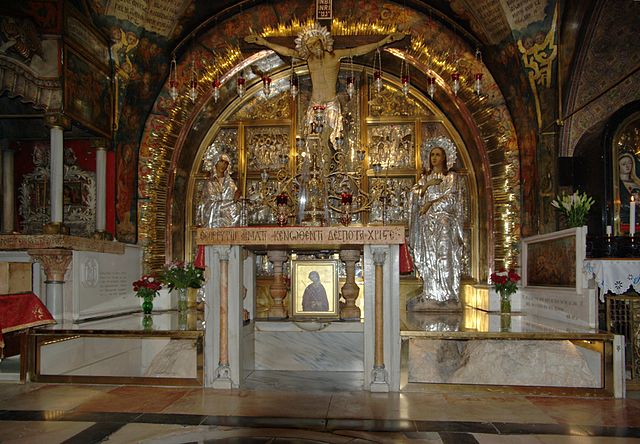
(9-22-05)
***
[originally stimulated in debate with a Lutheran professor of history]
***
Once real presence and sacrifice are directly merged (as is the case even with the early Church fathers in many instances), then it is necessarily a propitiatory sacrifice, not merely the bread and wine, by definition. The bread and wine have been transformed into the Body and Blood of Jesus, and so what we have is the “being made present” of Calvary. Hence, Sacrifice of the Mass, and hence, adoration.
Of what sense is it to merely offer God bread and wine? The New Covenant sacrifice is Jesus’ propitiatory, atoning death on our behalf, not mere food or bulls and goats. That’s the whole point, isn’t it? Offering the Father bread and wine after Calvary is a spiritual retrogression, not progression, as if the infinite power of the cross is made null and void and we are back to mere symbolism and allegory.
For some reason Luther and Lutherans balked at the consistency of the real flesh and blood of Jesus being the same flesh and blood which was “poured out for you” at Calvary. Having accepted the miracle of transformation in some fashion, they refuse to believe that God would make the sacrifice on the cross present again at Mass (and somehow make out — quite incredibly — that this is idolatry). But this is what the fathers taught.
They were teaching more than merely thanksgiving or an offering of bread and wine. For example:
Jaroslav Pelikan:
. . . this doctrine of the real presence believed by the church and affirmed by its liturgy was closely tied to the idea of the Eucharist as a sacrifice. Many of the passages we have already cited concerning the recollection and the real presence spoke also of the sacrifice . . .
. . . Liturgical evidence suggests an understanding of the Eucharist as a sacrifice, whose relation to the sacrifices of the Old Testament was one of archetype to type, and whose relation to the sacrifice of Calvary was one of “re-presentation,” just as the bread of the Eucharist “re-presented” the body of Christ.
Note how real presence and sacrifice are connected. This is the propitiatory sacrifice; otherwise, real presence would have to be disconnected from the consecration and presentation.
The Catholic Encyclopedia notes Tertullian’s “sacrificial realism”:
[Y]et in another passage (De orat., c., xix) he calls Holy Communion “participation in the sacrifice” (participatio sacrificii), which is accomplished “on the altar of God” (ad aram Dei); he speaks (De cult fem., II, xi) of a real, not a mere metaphorical, “offering up of sacrifice” (sacrificium offertur); he dwells still further as a Montanist (de pudicit, c., ix) as well on the “nourishing power of the Lord’s Body” (opimitate dominici corporis) as on the “renewal of the immolation of Christ” (rursus illi mactabitur Christus).
According to [Irenaeus] (Adv. haer., iv, 18, 4) it is the Church alone “that offers the pure oblation” (oblationem puram offert), . . .
Hippolytus of Rome (d. 235) . . . writes (Fragm. in Prov., ix, i, P. G., LXXX, 593), “The Word prepared His Precious and immaculate Body (soma) and His Blood (aima), that daily kath’ekasten) are set forth as a sacrifice (epitelountai thyomena) on the mystic and Divine table (trapeze) as a memorial of that ever memorable first table of the mysterious supper of the Lord”.
Philip Schaff summarizes what I stated above, in these words:
The ante-Nicene fathers uniformly conceived the Eucharist as a thank-offering of the church; the congregation offering the consecrated elements of bread and wine, and in them itself, to God. This view is in itself perfectly innocent, but readily leads to the doctrine of the sacrifice of the mass, as soon as the elements become identified with the body and blood of Christ, and the presence of the body comes to be materialistically taken.
Once you combine real presence and sacrifice, you have the mass. It’s not fully developed, but it’s there, and Schaff can readily see that.
Likewise, The Oxford Dictionary of the Christian Church: “From early times the Eucharistic offering was called a sacrifice in virtue of its immediate relation to the sacrifice of Christ.” It’s not symbolic (bread and wine), but “immediate” (a realist view of the Body and Blood).
J. N. D. Kelly says of Justin’s view:
The bread and wine, moreover, are offered ‘for a memorial (eis anamnasin) of the passion,’ a phrase which in view of his identification of them with the Lord’s body and blood implies much more than an act of purely spiritual recollection. Altogether it would seem that, while his language is not fully explicit, Justin is feeling his way to the conception of the eucharist as the offering of the Saviour’s passion.
There is more than enough indication, it seems to me (and also to these Protestant historians) to suggest that the Church fathers possessed the kernel of the “propitiatory sacrifice” view. That’s because they spoke of sacrifice, and connected this directly with the Body and Blood. That’s it. Once you get to that point, that is the Mass, as the Catholic Encyclopedia said about Irenaeus, he having put those two things together. So the notion is there; it’s just not as explicitly developed, as is the case with all other doctrines.
I trust (in the intellectual sense) these Protestant historians I have cited, to give an accurate report of patristic theology, because I’ve always found them to be trustworthy guides in the past. So I fully expect to see their conclusions verified upon closer inspection.
The presence of this other kind of sacrifice of thanksgiving and the offertory, etc., does not rule out the propitiatory sacrifice. So simply proving the existence of that does not make the Protestant argument prevail. We freely recognize that these other ideas are there, too.
If we can pray the prayers that God taught us (e.g., the Lord’s Prayer, and present them to God, why is it unthinkable to “present” Jesus’ Sacrifice on the Cross to the Father, in remembrance of this holiest and most important of all salvific events?
Everything is of a piece: centered on the cross. The Rosary is Jesus-centered, focusing on His life; crucifixes remind us of what He did for us; the Mass actually makes that act supernaturally present. God allows men to play a part in the supernatural occurrence, just as He allows them to play a role in the transformation of the elements int to Body and Blood.
The whole point of the Mass is to not only “remember” what Jesus did for us (abstract, non-literal), but to actually be brought supernaturally to the very foot of the Cross on Calvary (concrete reality). This is Christianity, That’s what God intended for His Church. Church is not a bare so-called “altar” with a Bible on it. Jesus is present in a Catholic Church; not just spiritually, but physically!
It is no problem for Him to perform a miracle and to transcend space and time, and so we can be at Calvary just as the persons alive at that time in history were.
And we can worship Jesus as if He were standing in the room, as if we were with Him on the shores of the Sea of Galilee. I’ve always wanted to be closer to Jesus, in any way that I can, so I was delighted to discover all the fuller truths of Catholicism in this regard. We don’t just tell stories about Jesus; we also receive Him into our bodies and worship Him at Church, just as people who fell at His feet during His earthly sojourn did.
Ephesians 5:2 And walk in love, as Christ loved us and gave himself up for us, a fragrant offering and sacrifice to God.
Note what is going on here:
1. We are to walk in love as Christ did, including His sacrifice. Does that not imply that we should offer some similar tangible sacrifice to God? What better sacrifice than Jesus on the cross?!
2. This sacrifice is “Godward”, not “manward.” Jesus offered His sacrifice to God the Father (precisely as the priest does, standing in His place).
3. The cross is a “fragrant offering.” This is entirely reminiscent of the worship scene in heaven, in Revelation 5:6-13. There we learn that Jesus is portrayed as a Lamb slain (5:6). He is worshiped, with “golden bowls full of incense” (hearkening back to the procedures of Temple sacrifice: 5:7). Jesus’ sacrificial death is then mentioned again in 5:9 and 5:12.
4. In light of “This is My Body. Do this in remembrance of Me,” it makes all the biblical sense in the world that Christian weekly worship is of a nature something like what we find in the Catholic Mass.
St. Paul also regards himself and/or his sufferings as an offering or sacrifice. This is a recurring motif:
2 Corinthians 4:10 Always carrying in the body the death of Jesus, so that the life of Jesus may also be manifested in our bodies. (cf. 2 Cor 1:5-7)
Philippians 2:17 Even if I am to be poured out as a libation upon the sacrificial offering of your faith, I am glad and rejoice with you all. (cf. 2 Cor 6:4-10)
Philippians 3:10 That I may know him and the power of his resurrection, and may share his sufferings, becoming like him in his death. (cf. Gal 2:20)
2 Timothy 4:6 For I am already on the point of being sacrificed; the time of my departure has come. (cf. Rom 12:1)
In this verse and in Philippians 2:17, the Greek word for libation and sacrifice is spendomai. In the Septuagint, the Greek translation of the Old Testament which was the Bible of the early Christians, this term is used for a variety of offerings and sacrifices commanded by the Mosaic Law (for example, Genesis 35:14; Exodus 29:12, 38 ff.; Leviticus 4:7 ff.; 23:37). Most intriguing is its occurrence with reference to the Messiah, Jesus, in Isaiah 53:12: “. . . he poured out his soul to death . . .” It appears, then, that St. Paul is stressing a mystical, profound identification with Jesus even in His death (as also in 2 Corinthians 4:10 and Philippians 3:10 above).
In some mysterious, glorious way God chooses to involve us in the very Redemption (always in a secondary and derivative sense, but actual nonetheless), just as He voluntarily involves us in His Providence by means of prayer and evangelism, and in His Creation by our procreation and childbirth.
Jesus’ sufferings are ours, and ours are His in a very real sense, as St. Paul unmistakably teaches, particularly and most strikingly in Colossians 1:24:
Colossians 1:24 Now I rejoice in my sufferings for your sake, and in my flesh I complete what is lacking in Christ’s afflictions for the sake of his body, that is, the church. (cf. 2 Cor 11:23-30; Gal 6:17)
If believers are so inexorably identified with the sufferings of Jesus, that leads right to the cross, and that is what Catholics experience every Sunday at Mass. God always draws further and further in those who are willing to follow and worship Him: all the way to Calvary.
This is historic Christianity, and whatever brand of Christianity today tries to distance itself from this aspect is much worse, and that much more spiritually impoverished for the loss.
***
Photo credit: Church of the Holy Sepulchre in Jerusalem. This is Golgotha or Calvary: the place where Jesus was crucified. I was there in October 2014: the most amazing moment of my life. Photograph by Berthold Werner (9-24-10) [Wikimedia Commons / Creative Commons Attribution-Share Alike 3.0 Unported, 2.5 Generic, 2.0 Generic and 1.0 Generic license]
***


